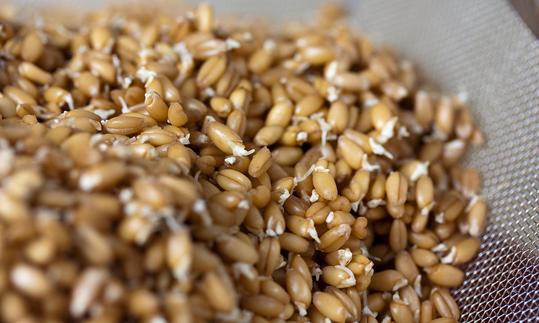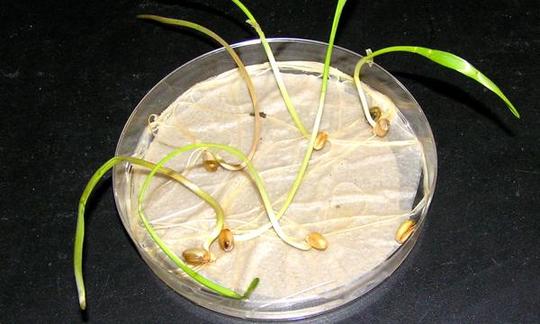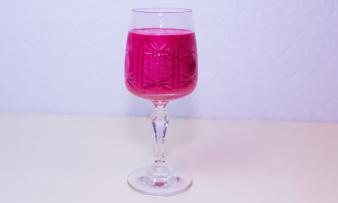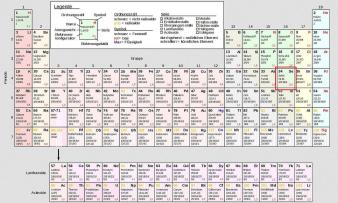Table of contents
Use in the kitchen
Germinated wheat ( Triticum ) refers to wheat grains that are in the germination stage. These wheat germs (organic) contain valuable nutrients when raw.
Sprouted wheat has a pleasantly sweet and slightly nutty taste. It can be eaten raw, cooked or fried. Fresh wheat sprouts go particularly well as raw food in salads and fruit salads. They can also be stirred into muesli, yoghurt and porridge. Sprouted wheat can also be used for smoothies and vegan shakes to ensure a suitable consistency and a unique taste. The sprouts can be added to all kinds of vegetarian and vegan dishes.
When cooked, sprouted wheat can replace rice and pasta as a warm side dish. Fried in a pan, the healthy sprouts liven up colorful vegetable dishes. They also make a good filling for wraps and sandwiches. Sprouted wheat is also used in bread and baked goods. Wheat sprouts are also popular as a decoration for desserts.
It is also possible to dry the sprouts to produce sprouted wheat flour (also called sprout flour). If you want to dry the sprouts yourself, you should use a dehydrator, as slow drying greatly promotes the growth of harmful microorganisms. The flour can be used to make bread, rolls, cakes or muffins, for example.
Homemade preparation
Germinated wheat can be easily grown at home. Since the conditions for germination of wheat are ideal for bacteria, you have to pay particular attention to the hygiene of the germination equipment, the germination aids, the working environment and your own hands. When using conventional seeds, pre-treatment can lead to the seeds not germinating or not germinating as desired. Untreated, whole wheat grains (organic) are best for germination.
How can you germinate wheat? You can make germinated wheat grains in a sprouting jar or a sprouting device. First, you should rinse the raw wheat grains thoroughly and then soak them in lukewarm water for 6-12 hours. To do this, fill the grains into a sprouting jar and cover with warm water. Note that one cup of wheat grains yields about 3-4 cups of wheat sprouts. After the soaking time, you can pour off the water. Rinse the wheat grains several times, pour in fresh water and pour again after about 10 minutes. Let the grains drain well. They should be moist, but not wet, otherwise they will start to mold. You can now germinate the grain at room temperature (about 20 °C) and with enough light. Rinse the grains thoroughly once or twice a day. After about 24-48 hours, you will see the first small sprouts in the wheat. You can decide for yourself how long the seeds will germinate and how big the seedlings will be - and experiment with them to suit your taste.
The germinated grains taste best when freshly harvested. This is also when they contain the most wheat nutrients. During the growth phase, small, furry secondary roots form, which are often mistaken for mold. Make sure that the wheat sprouts are not longer than the wheat grain itself, as long sprouts often taste bitter. If the germinated wheat begins to smell strange and develop mold, the seeds should be thrown away immediately and the sprouting equipment should be thoroughly cleaned.
To stop the germination process, it is sufficient to store the freshly rinsed, drained sprouts in the refrigerator.
Vegan recipe for vegetable salad with wheat sprouts
Ingredients (for 2 people): 150 g raw vegan cream cheese; 100 g wheat, sprouted (raw, organic); 6 cherry tomatoes ; ½ organic cucumber ; 1 avocado ; 2 spring onions ; 1 carrot ; 1 bunch of fresh herbs, organic (e.g. chives, parsley, garden cress ); 1 teaspoon lemon juice ; some salt andblack pepper .
Preparation: Wash the cucumber and cut into small pieces. Peel the carrot and grate finely. Wash and quarter the tomatoes. Cut the avocado in half and remove the pit. Peel the flesh, cut into small cubes and mix with lemon juice. Put the prepared vegetables in a bowl, season with salt and pepper and mix everything well. Clean the spring onions and cut the stalks into fine rings. Wash the herbs, shake dry and chop finely. Rinse the sprouted wheat and let it drain. Mix the vegan cream cheese with the sprouts, onion rings and a third of the chopped herbs. Season with salt and pepper and spread the mixture over the prepared vegetables. Sprinkle the remaining herbs over the vegan raw food salad and serve.
Vegan recipes with wheat (sprouted) can be found under the note: " Recipes that have the most of this ingredient ".
| Not only vegans or vegetarians should read this: Vegans often eat unhealthily. Avoidable nutritional errors . |
Purchasing - Storage
Where can you buy sprouted grain? Wheat sprouts are often not available in supermarkets such as Coop, Migros, Denner, Volg, Spar, Aldi, Lidl, Rewe, Edeka, Hofer, Billa etc. In some stores (e.g. Coop, Migros, Spar, Rewe, Edeka ) wheat is occasionally available as whole grain (whole grain), sometimes even in organic quality. However, many of these supermarkets only offer whole wheat grains online. You can find organically produced wheat grains for sprouting in organic supermarkets such as Alnatura or Denn's Biomarkt, in health food stores, organic shops or in online shops. In addition, the sprouted wheat is available dried in some online shops and organic supermarkets or as so-called sprouted flour (or sprouted flour).
The warm, moist environment is not only ideal for germinated wheat, but also for bacteria and mold. If you treat the sprouts with heat when cooking, you can kill any germs that may be present, which can multiply during production, transport or storage in the store. However, this means that the food is no longer raw.
The availability of sprouted wheat varies depending on the size of the store, catchment area, etc. Our recorded food prices for the DA-CH countries can be found above under the ingredient image - and by clicking you can see their development at various suppliers.
Storage tips
Wheat sprouts are highly perishable foods with a shelf life of 3 to 4 days. Purchased sprouts should always be stored in a cool, dark place, ideally in the vegetable compartment of the refrigerator. Do not rinse the sprouts with water immediately after purchase, as the excess liquid can accelerate decay and lead to premature mold formation. But open the packaging slightly before storing so that air can circulate. Even sprouted grains can be kept for about 2-3 days after harvest. The shorter shelf life is due to the fact that the sterile conditions at home are not the same as in industrial production. Always test the appearance, smell and taste of the sprouts before eating them.
Ingredients - Nutritional values - Calories
100 g of raw sprouted wheat grains have an energy content of 198 kcal and consist of 43 g of carbohydrates . They contain 1.1 gof fiber per 100 g and have a fat content of 1.3 g/100g. The protein content of 7.5 g/100g can be compared with that of rice flakes (7.4 g/100g) or raw sweetcorn (7.1 g/100g). 1
Manganese is present in germinated wheat at 1.9 mg/100g, which makes up 93% of the daily requirement. Shelled hemp seeds contain a similar amount (2 mg/100g). Unpeeled hemp seeds (7.6 mg/100g) and wheat germ (13 mg/100g) contain significantly more manganese. 1
According to USDA values, the amount of selenium in 100 g of wheat (germinated) accounts for around 77% of the daily requirement. The content of 42 µg/100g can be compared with that of wheat flour (40 µg/100g). Wheat germ (79 µg/100g), wheat bran (78 µg/100g) and especially Brazil nuts (1917 µg/100g) have a higher selenium content. However, these are values from the USA. 1
In many areas of Europe, wheat has a lower selenium and iodine content. The soil contains relatively little of these micronutrients, so that nutritional deficiencies can occur. This is why the salt is iodized. So-called selenium wheat can help, as it is particularly rich in selenium thanks to certain fertilization. 18
The 0.12 g of tryptophan contained in 100 g covers 46% of the daily requirement. Millet has a comparable amount of this amino acid (0.12 g/100g). The content is significantly higher in chia seeds (0.44 g/100g). 1
Does sprouted wheat contain vitamins? Sprouted wheat grains contain , among other things, thiamine (vitamin B1 ), folate (folic acid), vitamin B6, niacin, pantothenic acid and riboflavin in significant quantities. Thiamine is the most abundant vitamin and, at 0.22 g/100g, covers 20% of the daily requirement. 1,13,14
The total ingredients of wheat (germinated), the coverage of the daily requirement and comparison values with other ingredients can be found in our nutrient tables. In the article Nutrients explained you will get a detailed insight into the topic.
Effects on health
Are wheat sprouts healthy? Unlike wheat grains, wheat sprouts can be eaten raw. Many vitamins and minerals are retained without the effect of heat. In addition, the content of biologically active substances in wheat sprouts is higher than in heated wheat grains, as many vitamins and enzymes are only formed during the germination process 2 or reach a higher content through germination. Among other things, germinated wheat is richer in folate and thiamine (vitamin B1 ). 13,14 The spectrum of effects of the valuable ingredients in wheat is therefore optimally developed in raw, germinated form. The nutrient content of wheat sprouts, however, depends on the conditions under which they grow (e.g. temperature, humidity, culture medium, soaking and germination time). 3,15
Germinated wheat is easier to digest: the content of stachyose and raffinose, which are responsible for flatulence, decreases during the germination process. 3 Germination also promotes the conversion of starch into simple sugars, thereby increasing their digestibility. 15 This also explains the slightly sweet taste of the sprouts.
Wheat sprouts also provide the body with antioxidants that can scavenge free radicals, lower LDL cholesterol levels, and alter immune functions by reducing the inflammatory response in people with autoimmune diseases. According to one study, the best conditions for developing high antioxidant content during germination are a 24-hour soaking time and a 7-day germination period with two waterings per day. 3
Secondary plant substances
Many of the health effects of wheat sprouts can be attributed to the secondary plant substances they contain. Our article on secondary plant substances provides an overview of the classification of substance groups, their occurrence in foods and possible effects on humans. Sprouted wheat contains the following secondary plant substances, among others:
- Isoprenoids: Carotenoids (beta-carotene) 20
- Polyphenols: Phenolic acids: hydroxybenzoic acids (protocatechuic acid, syringic acid, vanillic acid), hydroxycinnamic acids (ferulic acid, p-coumaric acid, caffeic acid); flavonoids: flavanols (catechin), anthocyanins (pelargonidin, cyanidin, delphinidin), flavonol (quercetin) 19,20,22
- Protease inhibitors: phytic acid, chlorophyll 19,21
However, it should be noted that the composition of secondary plant substances in germinated wheat can vary depending on the variety, time of harvest and growing conditions. Therefore, quantities are only of limited use and should only be understood roughly.
A comparative study of seeds and sprouts of colored wheat genotypes showed a higher content of biologically active compounds of polyphenolic nature in sprouts compared to seeds. 19
Beta-carotene is converted into vitamin A in the human body, which plays an important role in vision. You can read more about the positive health effects in our article on carotenoids . The phenolic compounds found in germinated wheat are known for their antioxidant effects. 21
The germination process breaks down the phytic acid contained in the wheat grain. Phytic acid has both advantages and disadvantages for the human organism. On the one hand, the acid binds minerals and trace elements in the human body, making them less available. On the other hand, phytic acid has an antioxidant effect and there is increasing discussion about its blood pressure-lowering effect, which is due to the delayed digestion of starch. You can read more about this in the article Phytic acid or phytate and soaking or germination .
The chlorophyll content in younger sprouts is higher than in older ones and may be due to the activation of the enzymes of chlorophyll synthesis. Chlorophyll absorbs light energy during photosynthesis and converts it into chemical energy. Various studies attribute an important role to chlorophyll in chemoprotection and anti-carcinogenesis. 21
Dangers - Intolerances - Side effects
Is sprouted grain unhealthy? The sprouted wheat grains are very healthy in themselves, but raw wheat sprouts can be carriers of various microorganisms and germs if handled unhygienically or incorrectly. Therefore, consumption as a raw food is only recommended for adults with an intact immune system. Children, the elderly, pregnant women and people with a weakened immune system should not eat the wheat sprouts raw, but always heat them before consumption. Although some nutrients are lost when heated, the benefits outweigh the disadvantages, because sprouts have been linked to outbreaks of disease in the past.
In particular, bacteria such as salmonella, Escherichia coli, listeria and viruses such as hepatitis A viruses multiply best in heat and moisture, such as those present when wheat grains germinate. It is almost impossible to prevent germs from multiplying during the production of sprouts. It is dangerous if the raw material contains pathogenic germs. The manufacturers of sprouts are obliged to test the goods for pathogenic germs before selling them. Consumers should wash the sprouts thoroughly before consumption, but microorganisms (bacteria and fungi) and viruses cannot be completely eliminated by washing.
Sprouted wheat is not gluten-free, but it contains less gluten than unsprouted wheat grains because the sprouting process reduces the content. 13,15 People who suffer from celiac disease or gluten sensitivity should be careful and avoid eating it if necessary. For more information on celiac disease, see the article Semolina .
Wheat germs contain heat-stable lectins. Animal studies show that these agglutinins (WGA = wheat germ agglutinins) affect the intestinal mucosa and have a negative effect on the pancreas and the immune system when administered in high doses. This is why the transfer of the WGA gene into crops to increase insect resistance has been criticized. Since some of the agglutinin passes through the intestinal wall and enters the bloodstream, this can have harmful effects on humans and animals. According to the study cited, the natural content of agglutinins in wheat germ cannot be classified as toxic. 7 Further research is still desirable because the results of animal studies (with high doses of pure agglutinins) and more recent in vitro studies on human cells cannot be used to draw direct conclusions about the human nutritional situation. 17
Ecological footprint - animal welfare
The CO 2 footprint of wheat in Denmark is estimated at 0.84 kg CO 2 eq/kg. It is therefore similar to that of other types of grain such as barley (0.83 kg CO 2 eq/kg) or rye (0.77 kg CO 2 eq/kg). 9 The additional production steps for germinating the wheat most likely increase the ecological footprint. The same applies to the amount of water required to produce 1 kg of germinated wheat. For 1 kg of ungerminated wheat grains, an average of 1827 liters is expected, which is significantly more water than for barley (1423 liters) or rye (1544 liters). 10
Organic wheat cultivation is preferable to conventional cultivation in many respects. For example, no synthetic fertilizers or pesticides are used, but the emissions produced are also significantly lower. This can be explained by the fact that nitrogen mineral fertilizers are not used, which generate more emissions during production and application. 11
Targeted research is needed to anticipate future developments and changes in wheat cultivation as a result of global warming. The requirements for cultivation and the corresponding adaptations vary from region to region - in lower latitudes, higher temperatures will occur in the future, accompanied by water shortages and droughts. If you still want to cultivate wheat in these areas, you need a plant that is resistant to heat and drought. In other regions, the increased temperatures may lead to an improvement in yield. 12
For detailed explanations of various sustainability indicators (such as ecological footprint, CO2 footprint, water footprint), see our article: What does the ecological footprint mean?
Worldwide occurrence - cultivation
Wheat ( Triticum ) probably comes from the area between Europe and Asia (Eurasia), more precisely from the Fertile Crescent (in the north of the Arabian Peninsula). 4 Based on finds dating back over 10,000 years, wheat is considered to be one of the oldest cultivated plants in human history. The genetic makeup of today's wheat is very complex. According to recent research, soft wheat ( Triticum aestivum L.) carries genes from the wheat ancestor Aegilops tauschii (goat grass) and wild emmer. 5 In 2018, after 13 years of work, researchers succeeded in completely sequencing the wheat genome (for Triticum aestivum L.). 16
Wheat is grown worldwide in temperate and subtropical regions of Asia, Europe, North and South America. 6
You can read more about the cultivation, harvesting and ecological aspects of wheat in the corresponding article.
Industrial production
How can you produce wheat sprouts? Before producing sprouts, make sure that the wheat kernels are not contaminated with harmful bacteria, fungi or viruses. Heat treatment is recommended to remove such pathogens. 8 There are methods in which the kernels are immersed in hot water or pasteurised using steam. In some countries, conventional wheat kernels are also treated with hydrogen peroxide. However, heating before germination is not suitable for all seeds, as some seeds are too sensitive to it and are no longer able to germinate afterwards - or vitamins can be lost. The kernels must now be soaked in warm water for around 12 hours. This causes them to swell, the shell softens and the wheat can germinate. Wheat sprouts are left to germinate for between 2 and 7 days. During the germination process, they are kept in breeding containers in the sprouting room and grow at around 21 °C. Temperatures that are too high (around 30 °C) encourage the growth of fungi and bacteria. In order for the wheat to germinate, the grains need sufficient moisture. The seedlings are therefore given regular showers of warm water that are programmed at a time and run fully automatically.
Methods using ultrasound technology are intended to shorten the soaking and germination time and thus reduce the risk of microbial contamination.
Further information
The terms germs and sprouts are often used incorrectly as synonyms. From a botanical point of view, these are different parts of the developing plant. The word germ describes a young plant that develops from the seed. A germ includes the developing root buds and the visible parts of the plant, i.e. the entire plant. Sprouts, on the other hand, are exclusively the parts of the plant that grow above ground, i.e. the stems and the leaves that develop from them. The product name 'sprout flour' is therefore also suboptimal for flour made from germinated grain.
It is also important to be careful when distinguishing between the terms wheat germ and wheat sprout. Wheat germ does not refer to the germinated wheat grains, but rather to the germs that have been separated from the ungerminated grain and then crushed.
Alternative names
Germinated wheat grains can, as mentioned, also be referred to as wheat germ. In stores, the product is often called 'germinated wheat'. The terms wheat sprouts and wheat germ sprouts can also be found - although, as explained in the previous section, these are not entirely correct.
In English, the terms 'wheat, sprouted', 'sprouted wheat' or 'germinated wheat' are common.
Bibliography - 22 Sources (Link to the evidence)
| 1. | USDA United States Department of Agriculture. |
| 2. | Pini U. Das Bio-Food Handbuch. Ullmann Verlag: Potsdam; 2014: 702-704. |
| 3. | Yang F, Basu TK, Ooraikul B. Studies on germination conditions and antioxidant contents of wheat grain. International Journal of Food Sciences and Nutrition. 2001;52(4):319–330. |
| 4. | Pflanzenforschung de: Weizenanbau. |
| 5. | De Sousa T, Ribeiro M et al. The 10,000-year success story of wheat! Foods. 2021;10(9):2124. |
| 6. | Pahlow M. Das grosse Buch der Heilpflanzen. Gesund durch die Heilkräfte der Natur. Nikol Verlagsges. mbH: Hamburg; 2013; 483. |
| 7. | Pusztai A, Ewen SW et al. Antinutritive effects of wheat-germ agglutinin and other N-acetylglucosamine-specific lectins. Br J Nutr. July 1993;70(1):313–321. |
| 8. | Beck A, Busch G et al. Keimlinge als neuartige multifunktionelle Zutat in ökologischen Backwaren - Optimierung der Herstellung und Verwendung. FibL. 2010. |
| 9. | CONCITO. The Big Climate Database, version 1. Wheat, kernels, whole/cracked. 2021. |
| 10. | Mekonnen MM, Hoekstra AY. The green, blue and grey water footprint of crops and derived crop products. Hydrol. Earth Syst. Sci. 2011; 15: 1577-1600. |
| 11. | Lindenthal T, Markut T, Hörtenhuber S et al. Klimabilanz biologischer und konventioneller Lebensmittel im Vergleich. Ökologie und Landbau. 2010. |
| 12. | Ortiz R, Sayre K, Goaverts B et al. Climate change: Can wheat beat the heat? Agriculture, Ecosystems & Environment. 2008;126(1-2):46-58. |
| 13. | Koehler P, Hartmann G et al. Changes of Folates, Dietary Fiber, and Proteins in Wheat As Affected by Germination. Journal of Agricultural and Food Chemistry. 2007; 55(12): 4678–4683. |
| 14. | Plaza L, de Ancos B, Cano PM. Nutritional and health-related compounds in sprouts and seeds of soybean (Glycine max), wheat (Triticum aestivum L.) and alfalfa (Medicago sativa) treated by a new drying method. European Food Research and Technology. 2003;216(2):138–144. |
| 15. | Ikram A, Saeed F, Afzaal M et al. Nutritional and end‐use perspectives of sprouted grains: A comprehensive review. Food Science & Nutrition. 2021;9(8):4617–4628. |
| 16. | The International Wheat Genome Sequencing Consortium (IWGSC) et al. Shifting the limits in wheat research and breeding using a fully annotated reference genome. Science. 17. August 2018; 361(6403): eaar7191. |
| 17. | Pellegrina CD, Perbellini O et al. Effects of wheat germ agglutinin on human gastrointestinal epithelium: Insights from an experimental model of immune/epithelial cell interaction. Toxicology and Applied Pharmacology. June 2009;237(2):146–153. |
| 18. | Top agrar online. Spezialweizen hilft bei Selenmangel. 1. Januar 2009. |
| 19. | Sytar O, Bośko P, Živčák M, Brestic M, Smetanska I. Bioactive phytochemicals and antioxidant properties of the grains and sprouts of colored wheat genotypes. Molecules. September 2018;23(9):2282. |
| 20. | Benincasa P, Falcinelli B, Lutts S, Stagnari F, Galieni A. Sprouted grains: a comprehensive review. Nutrients. Februar 2019;11(2):421. |
| 21. | Park JJ, Park YS, Dhungana SK, Kim ID, Shin DH. Phytochemical and antioxidant properties of korean wheat sprouts. Korean Journal of Plant Resources. 1. Juni 2020;33(3):170–82. |
| 22. | Francis H, Debs E, Koubaa M, Alrayess Z, Maroun RG, Louka N. Sprouts use as functional foods. Optimization of germination of wheat (Triticum aestivum L.), alfalfa (Medicago sativa L.), and radish (Raphanus sativus L.) seeds based on their nutritional content evolution. Foods. Mai 2022;11(10):1460. |











Comments